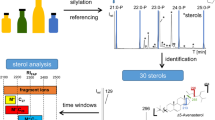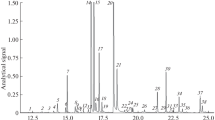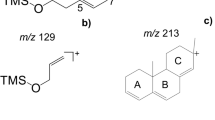Abstract
We developed a method for quantitatively analyzing some components of the unsaponifiable fraction of edible oils and validated its characteristics. The component composition of the unsaponifiable fraction of 26 edible oil species was studied by gas chromatography/mass spectrometry. Squalene, sterols, and triterpene alcohols were quantified in oils using cholestenol as an internal standard. Some correlations were found between the structure of sterols and triterpene alcohols and their retention indices and electron impact fragmentation. More than 150 chemical compounds—unsaponifiable components—were identified. The method can be used to estimate the concentration of sterols, triterpene alcohols, and squalene in edible oils and determine the authenticity of oils by the characteristic profiles of the unsaponifiable fraction.


Similar content being viewed by others
REFERENCES
Kozlowska, M., Gruczynska, E., Scibisz, I., et al., Food Chem., 2016, vol. 213, p. 450.
R (Guidelines) 4.1.1672-03: Guidelines for Quality Control and Safety of Dietary Supplements, Moscow, 2004.
Metody analiza biologicheski aktivnikh veshestv pishi (Methods for the Analysis of Biologically Active Substances of Food), Tutel’yan, V.A. and Eller, K.I., Eds., Moscow: Dinastiya, 2010.
Caligiani, A., Bonzanini, F., Palla, G., et al., Plant Foods Hum. Nutr., 2010, vol. 65, no. 3, p. 277.
Phillips, K.M., Ruggio, D.M., and Ashraf-Khorassani, M., J. Agric. Food Chem., 2005, vol. 53, no. 24, p. 9436.
Devyatlovskaya, A.N., Zhuravleva, L.N., and Alashkevich, Yu.D., Khim. Rastit. Sir’ya, 2014, no. 2, p. 195.
Balagozyan, E.A., Kurkin, V.A., and Pravdivtseva, O.E., Khim. Rastit. Sir’ya, 2016, no. 2, p. 67.
Flakelar, C.L., Prenzler, P.D., Luckett, D.J., et al., Food Chem., 2017, vol. 214, p. 147.
Zarrouk, W., Carrasco-Pancorbo, A., Zarrouk, M., et al., Talanta, 2009, vol. 80, no. 2, p. 924.
Fernandes, G.D., Porcari, A.M., Eberlin, M.N., et al., Food Chem., 2016, vol. 211, p. 661.
Hailat, I. and Helleur, R.J., Rapid Commun. Mass Spectrom., 2014, vol. 28, no. 2, p. 149.
Hatzakis, E., Dagounakis, G., Agiomyrgianaki, A., et al., Food Chem., 2010, vol. 122, no. 1, p. 346.
Piironen, V., Lindsay, D.G., Miettinen, T.A., et al., J. Sci. Food Agric., 2000, vol. 80, no. 7, p. 939.
Valitova, Yu.N., Sulkarnaeva, A.G., and Minibaeva, F.V., Biokhimiya, 2016, vol. 81, no. 8, p. 1050.
Gylling, H., Plat, J., Turley, S., et al., Atherosclerosis, 2014, vol. 232, no. 2, p. 346.
Goryainov, S.V., Esparza, S., Borisova, A.R., et al., Mass-Spektrom., 2019, vol. 16, no. 4, p. 293.
Halket, J.M. and Zaikin, V.G., Eur. J. Mass Spectrom., 2003, vol. 9, no. 1, p. 1.
Micera, M., Botto, A., Geddo, F., et al., Antioxidants, 2020, no. 9, p. 688.
Semenov, V.V., Rusak, V.V., Chartov, E.M., et al., Russ. Chem. Bull., 2007, vol. 56, no. 12, p. 2448.
Solati, Z., Baharin, B.S., and Bagheri, H., J. Am. Oil Chem. Soc., 2014, vol. 91, no. 2, p. 295.
Chaudrary, S., Chaudrary, P.S., Chikara, S.K., et al., Not. Bot. Horti Agrobot. Cluj-Napoca, 2018, vol. 46, no. 1, p. 22.
Wu, Y., Zhou, R., Wang, Z., et al., PLoS One, 2019, vol. 14, no. 3, e0212879.
Li, T.S.C., Beveridge, T.H.J., and Drover, J.C.G., Food Chem., 2007, vol. 101, no. 4, p. 1633.
Czaplicki, S., Ogrodowska, D., Derewiaka, D., et al., Eur. J. Lipid Sci. Technol., 2011, vol. 113, no. 12, p. 1456.
ACKNOWLEDGMENTS
The work was carried out using the equipment of the Center for Collective Use of the RUDN University and the Center for Collective Use “Analytical Center for the Problems of Deep Refining of Oil and Petrochemistry” of the Topchiev Institute of Petrochemical Synthesis, Russian Academy of Sciences.
Funding
The study was supported by the “RUDN University Program 5-100”. The analysis of coconut fruits, annual sunflower seeds, wheat germ, and sugar corn was supported within the State Assignment of the Topchiev Institute of Petrochemical Synthesis, Russian Academy of Sciences.
Author information
Authors and Affiliations
Contributions
All authors contributed to the work equally.
Corresponding author
Ethics declarations
The authors declare that they have no conflicts of interest.
Additional information
Translated by O. Zhukova
Rights and permissions
About this article
Cite this article
Goriainov, S.V., Esparza, C.A., Borisova, A.R. et al. Phytochemical Study of the Composition of the Unsaponifiable Fraction of Various Vegetable Oils by Gas Chromatography–Mass Spectrometry. J Anal Chem 76, 1635–1644 (2021). https://doi.org/10.1134/S1061934821140045
Received:
Revised:
Accepted:
Published:
Issue Date:
DOI: https://doi.org/10.1134/S1061934821140045




